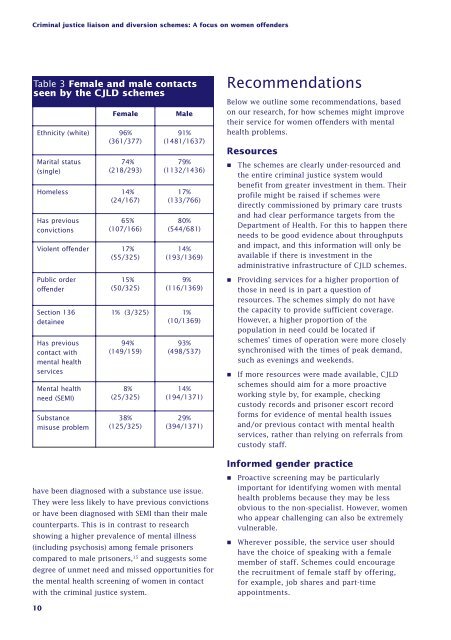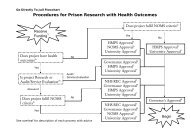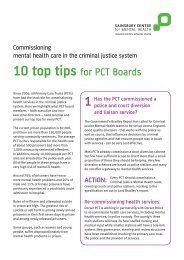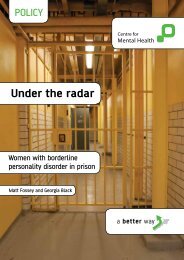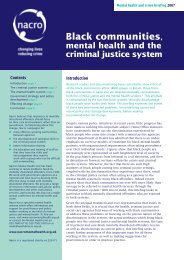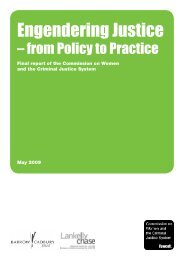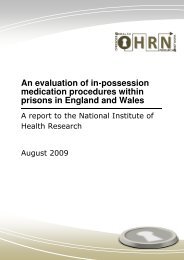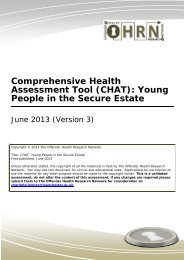Criminal justice liaison and diversion schemes - Offender Health ...
Criminal justice liaison and diversion schemes - Offender Health ...
Criminal justice liaison and diversion schemes - Offender Health ...
Create successful ePaper yourself
Turn your PDF publications into a flip-book with our unique Google optimized e-Paper software.
<strong>Criminal</strong> <strong>justice</strong> <strong>liaison</strong> <strong>and</strong> <strong>diversion</strong> <strong>schemes</strong>: A focus on women offendersTable 3 Female <strong>and</strong> male contactsseen by the CJLD <strong>schemes</strong>FemaleEthnicity (white) 96%(361/377)Marital status(single)74%(218/293)Homeless 14%(24/167)Has previousconvictions65%(107/166)Violent offender 17%(55/325)Male91%(1481/1637)79%(1132/1436)17%(133/766)80%(544/681)14%(193/1369)RecommendationsBelow we outline some recommendations, basedon our research, for how <strong>schemes</strong> might improvetheir service for women offenders with mentalhealth problems.ResourcesThe <strong>schemes</strong> are clearly under-resourced <strong>and</strong>the entire criminal <strong>justice</strong> system wouldbenefit from greater investment in them. Theirprofile might be raised if <strong>schemes</strong> weredirectly commissioned by primary care trusts<strong>and</strong> had clear performance targets from theDepartment of <strong>Health</strong>. For this to happen thereneeds to be good evidence about throughputs<strong>and</strong> impact, <strong>and</strong> this information will only beavailable if there is investment in theadministrative infrastructure of CJLD <strong>schemes</strong>.Public orderoffenderSection 136detaineeHas previouscontact withmental healthservicesMental healthneed (SEMI)Substancemisuse problem15%(50/325)9%(116/1369)1% (3/325) 1%(10/1369)94%(149/159)8%(25/325)38%(125/325)93%(498/537)14%(194/1371)29%(394/1371)Providing services for a higher proportion ofthose in need is in part a question ofresources. The <strong>schemes</strong> simply do not havethe capacity to provide sufficient coverage.However, a higher proportion of thepopulation in need could be located if<strong>schemes</strong>’ times of operation were more closelysynchronised with the times of peak dem<strong>and</strong>,such as evenings <strong>and</strong> weekends.If more resources were made available, CJLD<strong>schemes</strong> should aim for a more proactiveworking style by, for example, checkingcustody records <strong>and</strong> prisoner escort recordforms for evidence of mental health issues<strong>and</strong>/or previous contact with mental healthservices, rather than relying on referrals fromcustody staff.have been diagnosed with a substance use issue.They were less likely to have previous convictionsor have been diagnosed with SEMI than their malecounterparts. This is in contrast to researchshowing a higher prevalence of mental illness(including psychosis) among female prisonerscompared to male prisoners, 15 <strong>and</strong> suggests somedegree of unmet need <strong>and</strong> missed opportunities forthe mental health screening of women in contactwith the criminal <strong>justice</strong> system.Informed gender practiceProactive screening may be particularlyimportant for identifying women with mentalhealth problems because they may be lessobvious to the non-specialist. However, womenwho appear challenging can also be extremelyvulnerable.Wherever possible, the service user shouldhave the choice of speaking with a femalemember of staff. Schemes could encouragethe recruitment of female staff by offering,for example, job shares <strong>and</strong> part-timeappointments.10


